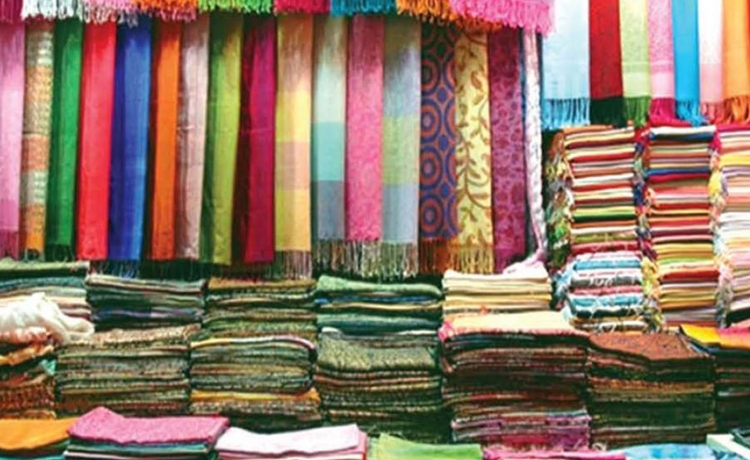Pashmina in Nepal

Published Date :10 Jan, 2016
Pashmina, the word has derived from Pashm which refers to the under fleece of the Himalayan Mountain goat called Chyangra (Capra Hircus). Today, it has become the name of the very best cashmere in the world. The value of Pashmina lies in the fact that it is the best and the finest cashmere in the world. It is the warmest, softest and lightest of the cashmeres.
Pashmina can only come from goats raised in the Himalayan mountain region. The Himalayan goats produce such exquisite wool because of the elevation at which they live. The capra Hircus goat, which is the source of Pashmina lives at elevations of 14,500 feet (4,500 m) and above, where temperatures rarely rise above minus 30 degrees Fahrenheit in winter. Pashmina is the goat’s soft underbelly down which is shed each spring and the pashmina fibers are collected either from the rocks and bushes or is brushed from the underbelly.
No harm comes to the Goats in the collection of the pashmina wool. The fibers are then sorted, cleaned and spun into Pashmina yarn. It is then woven by master weavers and individually dyed and dried. Practically any color imaginable can be achieved.
The ultimate indulgence is a 100% pure pashmina garment. But the most popular form of pashmina is called Pashmina Silk. It is a blend of approximately 70% Pashmina and 30% Silk. Fashionable customers prefer this blend because silk adds strength and shine to the garment.Pashmina has very high thermo conductivity and it is the best insulator. Pure pashmina wool is coarse and to delicate to wear. So, the pasmina is very soft as silk and is referred as cashmere. Cashmere is any wool under 19 microns in thickness. Pashmina is around 12-14 microns thick and 6 times finer than a human hair. (A human hair is 75 microns) It is lighter and far more delicate than cashmere wool. Manufacturers weave pashmina garments with a blend of silk. The proportion varies from 80:20 to 50:50 percent. The more the proportion of pashmina is , the more the price is.
In the past, pashmina was a royal symbol and was known as Fiber for Kings. During the 15th century, weaving of tapestry shawls was introduced from Turkistan by Zain-ul-Abdin, the ruler of Kashmir. This royal luxury was patronized by successive rulers like Akbar. When the Mughal Empire collapsed, these weavers became unemployed. Later on in the 19th century, Pashmina became a craze in France after a Napoleon presented an exotic shawl to Empress Josephine.
Most of the worlds Pashmina shawls are woven in Katmandu valley of Nepal and individually hand dyed these days. Nepal has the experience of dealing in Pashminas for more than two centuries.Pashmina shawls are an exclusive art of Kashmir. Other countries have unsuccessfully tried to duplicate the art. These shawls are woven by weavers who have been into this craftsmanship for generations and have inherited this art from their ancestors. They create the designs with floral borders, chinar leaves and paisley, mostly from their memory, inspired by the lakes, sunrise and sunset. The main types of embroidery done on Pashmina shawls are sozni, papier-mache and aari.
Sonzi is a needlework done on the sides of the shawl with paisleys and flowers. Paper-mache is done to cover the entire surface of the shawl and is hook embroidery. Designs are also made as Motifs which consists of leaves and flowers outlined in black. Though basic colors of Pashmina are grey, brown and white, it is efficiently dyed and is available in approximately 400 charming rainbow colors.
The price of an original Pashmina may vary from 100 to thousands of rupees depending on the craftsmanship. While dry cleaning the Pashminas, the chemicals used during the process may affect the texture of the garment in the long run. So washing it in warm water with a mild shampoo and drying it without twisting, in shade would sustain the quality of clothing for a longer time. Today’s fashion enthusiasts consider it as essential clothing in their wardrobe.
Related Blog(s)
- Experiencing Free Walking Tour Kathmandu with Shiva Dhakal
- Trekking en Poonhill
- Nagarkot to Changunarayan Hiking
- 5 must-see places in Kathmandu
- 5 tips for your first trek in Nepal
- Free Walking Tour Kathmandu
- Nagarkot Changunarayan Hiking
- Champa Devi Hiking
- Bandipur Village Tour
- Tips: before you trek to Nepal
- Langtang Trekking Review
- Poonhill Trekking Review
- Ghorepani Poonhill and Village Tour in Nepal
- Village Tour in Nepal : Gorkha
- Osho Tapoban Review - A Secluded Spiritual Getaway from Kathmandu
- Dakshinkali Pharping - A Local Experience!
- Pupal Yarsha Festival - 2016
- Lacs Gokyo et camps de base de l'everest avec Himkala Adventure
- Hiking in Nepal
- Singing Bowl in Nepal
- Rudraksha (Utrasum), Ammonite Fossil (Shaligram), Spatika (Quartz) in Nepal
- Thangka Painting in Nepal
- Gorkha-The Historical Place
- Shopping in Nepal with Himkala Adventure
- Trekking in Nepal with Himkala Adventure
- Garden of Dreams:The Garden of Six Seasons
- Pokhara: An Enchanting City
- Nepal: Beautiful Country in the World
- Bhaktapur: The City of Artistic Treasure
- World Tourism Day 2015




